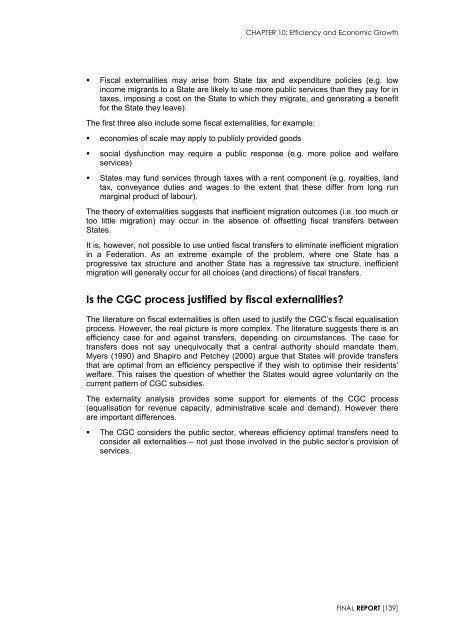Garnaut Fitzgerald Review of Commonwealth-State Funding
Garnaut Fitzgerald Review of Commonwealth-State Funding
Garnaut Fitzgerald Review of Commonwealth-State Funding
You also want an ePaper? Increase the reach of your titles
YUMPU automatically turns print PDFs into web optimized ePapers that Google loves.
CHAPTER 10: Efficiency and Economic Growth<br />
• Fiscal externalities may arise from <strong>State</strong> tax and expenditure policies (e.g. low<br />
income migrants to a <strong>State</strong> are likely to use more public services than they pay for in<br />
taxes, imposing a cost on the <strong>State</strong> to which they migrate, and generating a benefit<br />
for the <strong>State</strong> they leave).<br />
The first three also include some fiscal externalities, for example:<br />
• economies <strong>of</strong> scale may apply to publicly provided goods<br />
• social dysfunction may require a public response (e.g. more police and welfare<br />
services)<br />
• <strong>State</strong>s may fund services through taxes with a rent component (e.g. royalties, land<br />
tax, conveyance duties and wages to the extent that these differ from long run<br />
marginal product <strong>of</strong> labour).<br />
The theory <strong>of</strong> externalities suggests that inefficient migration outcomes (i.e. too much or<br />
too little migration) may occur in the absence <strong>of</strong> <strong>of</strong>fsetting fiscal transfers between<br />
<strong>State</strong>s.<br />
It is, however, not possible to use untied fiscal transfers to eliminate inefficient migration<br />
in a Federation. As an extreme example <strong>of</strong> the problem, where one <strong>State</strong> has a<br />
progressive tax structure and another <strong>State</strong> has a regressive tax structure, inefficient<br />
migration will generally occur for all choices (and directions) <strong>of</strong> fiscal transfers.<br />
Is the CGC process justified by fiscal externalities<br />
The literature on fiscal externalities is <strong>of</strong>ten used to justify the CGC’s fiscal equalisation<br />
process. However, the real picture is more complex. The literature suggests there is an<br />
efficiency case for and against transfers, depending on circumstances. The case for<br />
transfers does not say unequivocally that a central authority should mandate them.<br />
Myers (1990) and Shapiro and Petchey (2000) argue that <strong>State</strong>s will provide transfers<br />
that are optimal from an efficiency perspective if they wish to optimise their residents’<br />
welfare. This raises the question <strong>of</strong> whether the <strong>State</strong>s would agree voluntarily on the<br />
current pattern <strong>of</strong> CGC subsidies.<br />
The externality analysis provides some support for elements <strong>of</strong> the CGC process<br />
(equalisation for revenue capacity, administrative scale and demand). However there<br />
are important differences.<br />
• The CGC considers the public sector, whereas efficiency optimal transfers need to<br />
consider all externalities – not just those involved in the public sector’s provision <strong>of</strong><br />
services.<br />
FINAL REPORT [139]

















